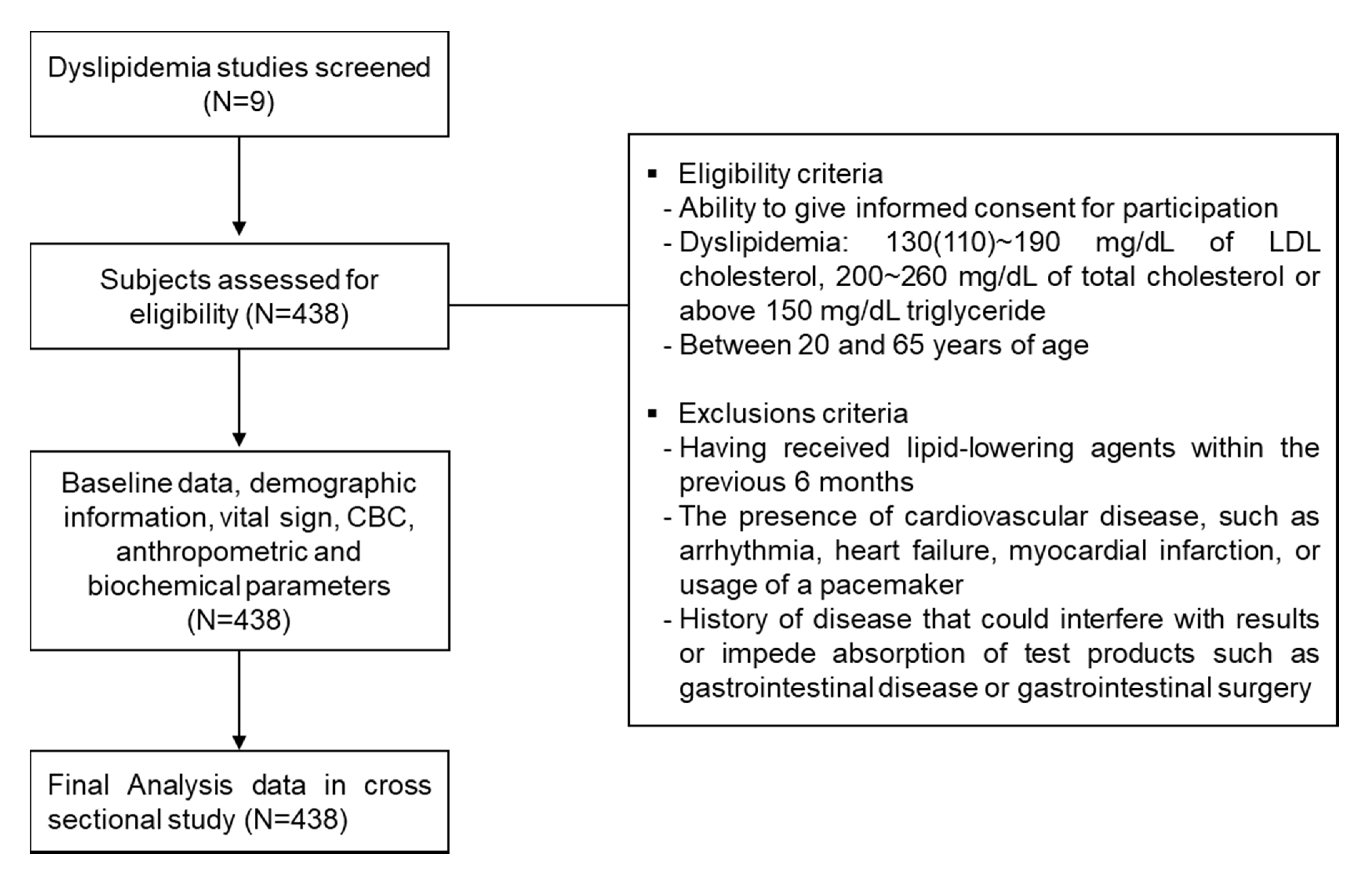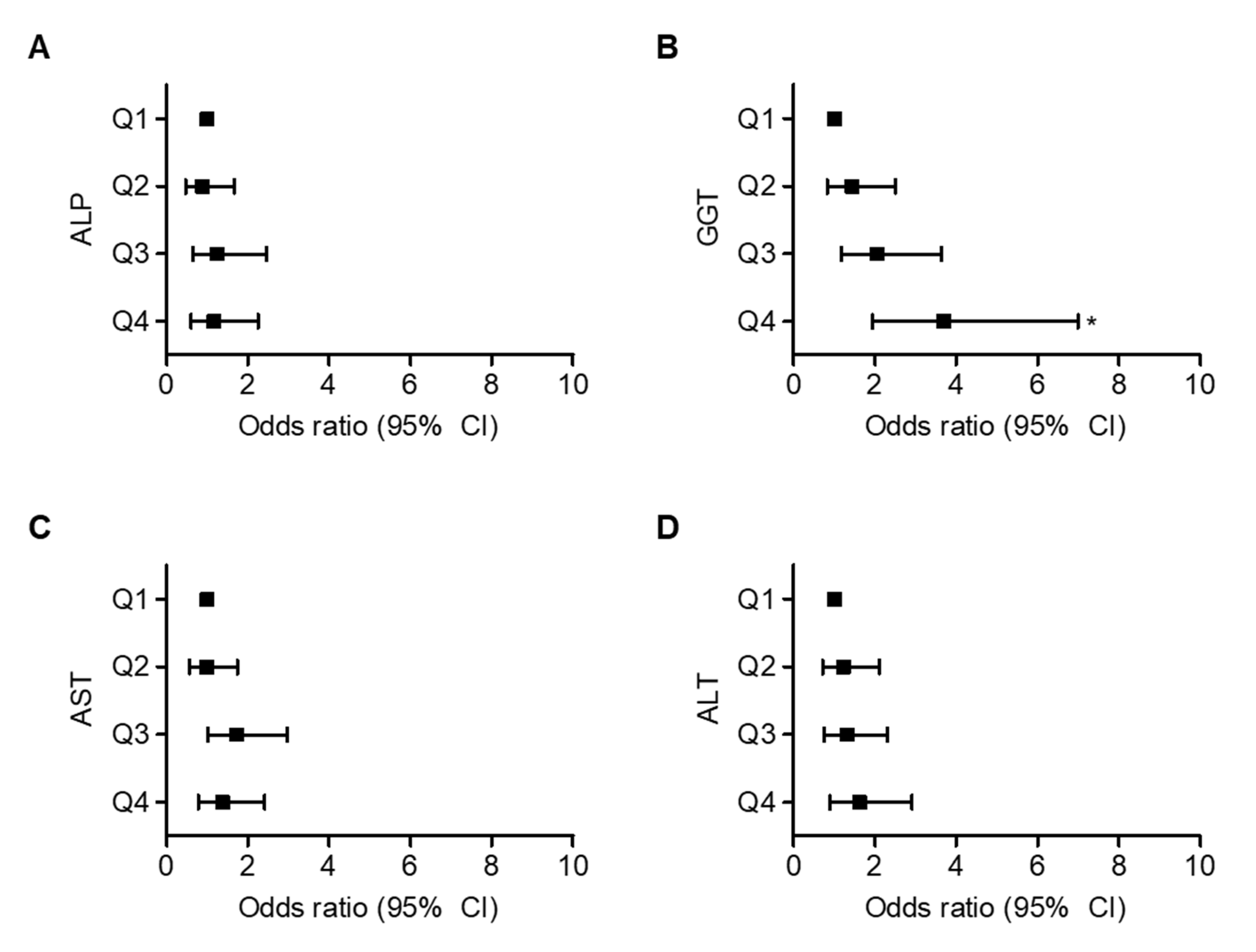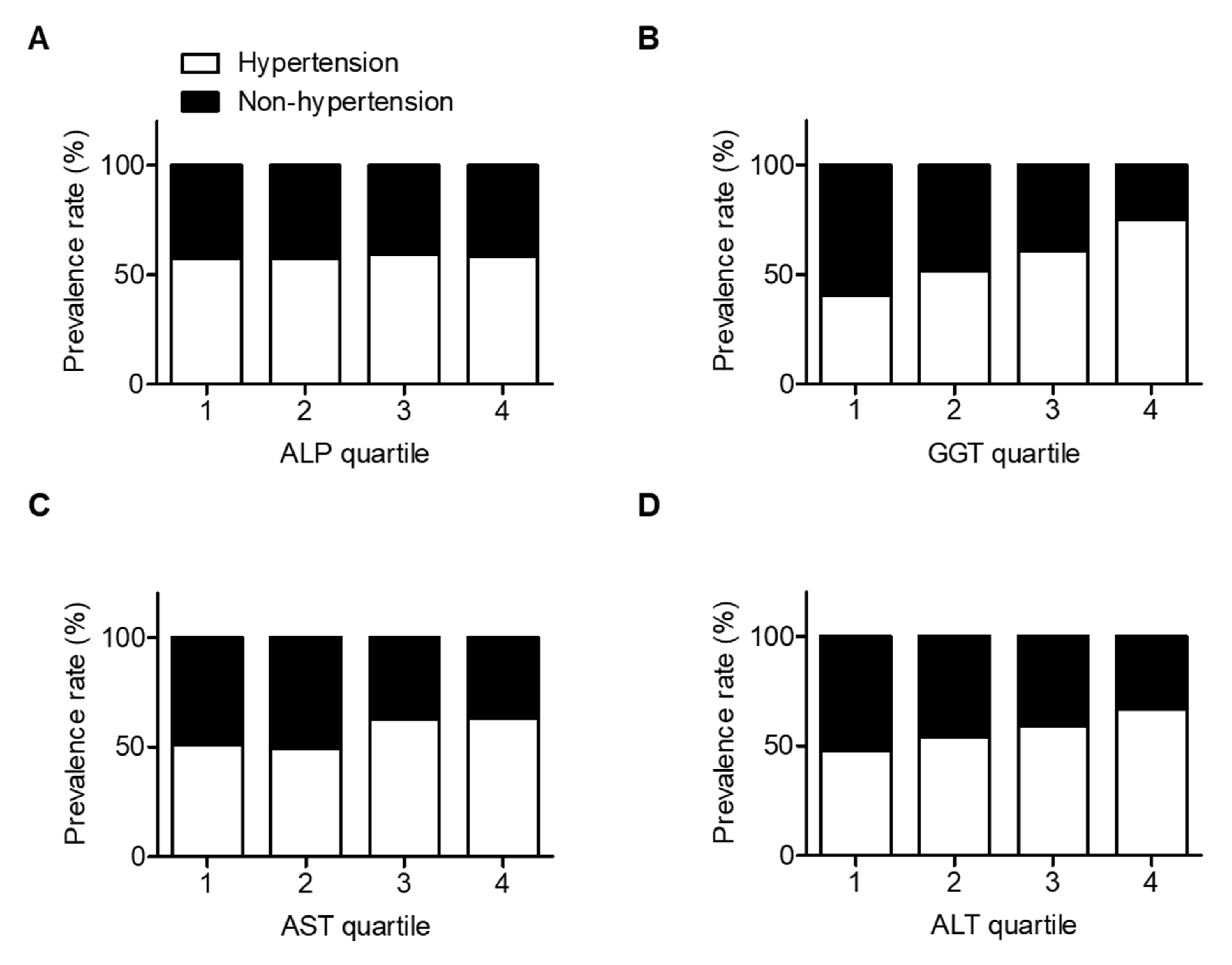The Associations between Liver Enzymes and Cardiovascular Risk Factors in Adults with Mild Dyslipidemia
Abstract
1. Introduction
2. Subjects and Methods
2.1. Study Population
2.2. Data Collection and Laboratory Measurements
2.3. Definition of Hypertension
2.4. Statistical Analysis
3. Results
3.1. Characteristics of the Study Population
3.2. Changes in Cardiovascular Risk Factors along the Liver Enzyme Quartiles
3.3. Correlation of Liver Enzymes with Cardiovascular Risk Factors
3.4. Association between Liver Enzymes and Cardiovascular Risk Factors
3.5. ORs of Hypertension along the Liver Enzyme Quartiles
3.6. Prevalence of Hypertension According to Liver Enzyme Quartiles by Trend Analysis
4. Discussion
Supplementary Materials
Author Contributions
Funding
Conflicts of Interest
References
- Elias, P.K.; Elias, M.F.; D’Agostino, R.B.; Sullivan, L.; Wolf, P. Serum cholesterol and cognitive performance in the Framingham Heart Study. Psychosom. Med. 2005, 67, 24–30. [Google Scholar] [CrossRef] [PubMed]
- Nordestgaard, B.; Freiberg, J.; Jensen, J.; Tybjaerg-Hansen, A. Non-fasting triglycerides and risk of ischemic stroke in the general population. Atheroscler. Suppl. 2008, 9, 15. [Google Scholar] [CrossRef]
- Okamura, T.; Tanaka, H.; Miyamatsu, N.; Hayakawa, T.; Kadowaki, T.; Kita, Y.; Nakamura, Y.; Okayama, A.; Ueshima, H. The relationship between serum total cholesterol and all-cause or cause-specific mortality in a 17.3-year study of a Japanese cohort. Atherosclerosis 2007, 190, 216–223. [Google Scholar] [CrossRef] [PubMed]
- Nickenig, G. Central role of the AT1-receptor in atherosclerosis. J. Hum. Hypertens. 2002, 16, S26–S33. [Google Scholar] [CrossRef]
- Nickenig, G.; Harrison, D.G. The AT1-type angiotensin receptor in oxidative stress and atherogenesis: Part II: AT(1) receptor regulation. Circulation 2002, 105, 530–536. [Google Scholar] [CrossRef] [PubMed]
- Nickenig, G.; Harrison, D.G. The AT1-type angiotensin receptor in oxidative stress and atherogenesis: Part I: Oxidative stress and atherogenesis. Circulation 2002, 105, 393–396. [Google Scholar] [CrossRef] [PubMed]
- Casino, P.R.; Kilcoyne, C.M.; Quyyumi, A.A.; Hoeg, J.M.; Panza, J.A. The role of nitric oxide in endothelium-dependent vasodilation of hypercholesterolemic patients. Circulation 1993, 88, 2541–2547. [Google Scholar] [CrossRef] [PubMed]
- Creager, M.A.; Cooke, J.; Mendelsohn, M.E.; Gallagher, S.J.; Coleman, S.M.; Loscalzo, J.; Dzau, V.J. Impaired vasodilation of forearm resistance vessels in hypercholesterolemic humans. J. Clin. Investig. 1990, 86, 228–234. [Google Scholar] [CrossRef] [PubMed]
- Wilkinson, I.B.; Prasad, K.; Hall, I.R.; Thomas, A.; Maccallum, H.; Webb, D.J.; Frenneaux, M.P.; Cockcroft, J.R. Increased central pulse pressure and augmentation index in subjects with hypercholesterolemia. J. Am. Coll. Cardiol. 2002, 39, 1005–1011. [Google Scholar] [CrossRef]
- Reaven, G.M.; Lithell, H.; Landsberg, L. Hypertension and associated metabolic abnormalities—The role of insulin resistance and the sympathoadrenal system. N. Engl. J. Med. 1996, 334, 374–382. [Google Scholar] [CrossRef]
- Kurano, M. Dyslipidemia secondary to liver diseases. Jpn. J. Clin. Pathol. 2016, 64, 518–526. [Google Scholar]
- Anderson, K.M. Cholesterol and mortality. 30 years of follow-up from the Framingham study. JAMA 1987, 257, 2176–2180. [Google Scholar] [CrossRef] [PubMed]
- Whitfield, J.B. Gamma glutamyl transferase. Crit. Rev. Clin. Lab. Sci. 2001, 38, 263–355. [Google Scholar] [CrossRef] [PubMed]
- Björnsson, E.; Angulo, P. Non-alcoholic fatty liver disease. Scand. J. Gastroenterol. 2007, 42, 1023–1030. [Google Scholar] [CrossRef] [PubMed]
- De Alwis, N.M.W.; Day, C.P. Non-alcoholic fatty liver disease: The mist gradually clears. J. Hepatol. 2008, 48, S104–S112. [Google Scholar] [CrossRef] [PubMed]
- Fraser, A.; Harris, R.; Sattar, N.; Ebrahim, S.; Smith, G.D.; Lawlor, D. Gamma-glutamyltransferase is associated with incident vascular events independently of alcohol intake. Arter. Thromb. Vasc. Boil. 2007, 27, 2729–2735. [Google Scholar] [CrossRef]
- Kunutsor, S.K.; Apekey, T.A.; Khan, H. Liver enzymes and risk of cardiovascular disease in the general population: A meta-analysis of prospective cohort studies. Atherosclerosis 2014, 236, 7–17. [Google Scholar] [CrossRef]
- Lee, H.; Shin, N.W.; Lee, T.H.; Yang, H.-K.; Ahn, E.; Yoon, J.-M.; Lee, H.-K.; Suh, B.; Son, K.Y.; Kim, J.S.; et al. Association between change in serum aminotransferase and mortality. Medicine 2016, 95, e3158. [Google Scholar] [CrossRef]
- Whelton, P.K.; Carey, R.M.; Aronow, W.S.; Casey, N.E.; Collins, K.J.; Himmelfarb, C.D.; DePalma, S.M.; Gidding, S.; Jamerson, K.A.; Jones, D.W.; et al. 2017 ACC/AHA/AAPA/ABC/ACPM/AGS/APhA/ASH/ASPC/NMA/PCNA Guideline for the Prevention, Detection, Evaluation, and Management of High Blood Pressure in Adults: Executive Summary: A Report of the American College of Cardiology/American Heart Association Task Force on Clinical Practice Guidelines. Circulation 2018, 138, e426–e483. [Google Scholar]
- Liu, C.; Zhou, W.-N.; Lü, Z.; Wang, X.-T.; Qiu, Z.-H. The associations between liver enzymes and the risk of metabolic syndrome in the elderly. Exp. Gerontol. 2018, 106, 132–136. [Google Scholar] [CrossRef]
- Lee, D.-H.; Jacobs, D.R.; Gross, M.I.; Kiefe, C.; Roseman, J.; Lewis, C.E.; Steffes, M. Gamma-glutamyltransferase is a predictor of incident diabetes and hypertension: The Coronary Artery Risk Development in Young Adults (CARDIA) Study. Clin. Chem. 2003, 49, 1358–1366. [Google Scholar] [CrossRef] [PubMed]
- Paolicchi, A.; Emdin, M.; Ghliozeni, E.; Ciancia, E.; Passino, C.; Popoff, G.; Pompella, A. Human atherosclerotic plaques contain gamma-glutamyl transpeptidase enzyme activity. Circulation 2004, 109, 1440. [Google Scholar] [CrossRef] [PubMed]
- Paolicchi, A.; Minotti, G.; Tonarelli, P.; Tongiani, R.; De Cesare, D.; Mezzetti, A.; Dominici, S.; Comporti, M.; Pompella, A. Gamma-glutamyl transpeptidase-dependent iron reduction and LDL oxidation—A potential mechanism in atherosclerosis. J. Investig. Med. 1999, 47, 151–160. [Google Scholar]
- Jousilahti, P.; Rastenyte, D.; Tuomilehto, J. Serum gamma-glutamyl transferase, self-reported alcohol drinking, and the risk of stroke. Stroke 2000, 31, 1851–1855. [Google Scholar] [CrossRef] [PubMed]
- Lee, D.-H.; Blomhoff, R.; Jacobs, D.R. ReviewIs Serum gamma glutamyltransferase a marker of oxidative stress? Free. Radic. Res. 2004, 38, 535–539. [Google Scholar] [CrossRef] [PubMed]
- Dowla, S.; Aslibekyan, S.; Goss, A.; Fontaine, K.; Ashraf, A.P. Dyslipidemia is associated with pediatric nonalcoholic fatty liver disease. J. Clin. Lipidol. 2018, 12, 981–987. [Google Scholar] [CrossRef]
- Sanyal, A.J. Mechanisms of Disease: Pathogenesis of nonalcoholic fatty liver disease. Nat. Clin. Pract. Gastroenterol. Hepatol. 2005, 2, 46–53. [Google Scholar] [CrossRef]
- Browning, J.D.; Horton, J.D. Molecular mediators of hepatic steatosis and liver injury. J. Clin. Investig. 2004, 114, 147–152. [Google Scholar] [CrossRef]
- Lee, H.J.; Lee, C.H.; Kim, S.; Hwang, S.-Y.; Hong, H.C.; Choi, H.Y.; Chung, H.S.; Yoo, H.J.; A Seo, J.; Kim, S.G.; et al. Association between vascular inflammation and non-alcoholic fatty liver disease: Analysis by 18F-fluorodeoxyglucose positron emission tomography. Metabolism 2017, 67, 72–79. [Google Scholar] [CrossRef]
- Liu, Z.; Que, S.; Ning, H.; Wang, L.; Peng, T. Elevated alanine aminotransferase is strongly associated with incident metabolic syndrome: A meta-analysis of prospective studies. PLoS ONE 2013, 8, e80596. [Google Scholar] [CrossRef]
- Stranges, S.; Dorn, J.M.; Muti, P.; Freudenheim, J.L.; Farinaro, E.; Russell, M.; Nochajski, T.H.; Trevisan, M. Body fat distribution, relative weight, and liver enzyme levels: A population-based study. Hepatology 2004, 39, 754–763. [Google Scholar] [CrossRef] [PubMed]
- Kengne, A.-P.; Czernichow, S.; Stamatakis, E.; Hamer, M.; Batty, G.D. Gamma-glutamyltransferase and risk of cardiovascular disease mortality in people with and without diabetes: Pooling of three British Health Surveys. J. Hepatol. 2012, 57, 1083–1089. [Google Scholar] [CrossRef] [PubMed]
- Rahmani, J.; Miri, A.; Namjoo, I.; Zamaninour, N.; Maljaei, M.B.; Zhou, K.; Černevičiūtė, R.; Mousavi, S.M.; Varkaneh, H.K.; Salehisahlabadi, A.; et al. Elevated liver enzymes and cardiovascular mortality. Eur. J. Gastroenterol. Hepatol. 2019, 31, 555–562. [Google Scholar] [CrossRef] [PubMed]
- Choi, K.M.; Han, K.; Park, S.; Chung, H.S.; Kim, N.H.; Yoo, H.J.; Seo, J.-A.; Kim, S.G.; Kim, N.H.; Baik, S.H.; et al. Implication of liver enzymes on incident cardiovascular diseases and mortality: A nationwide population-based cohort study. Sci. Rep. 2018, 8, 3764. [Google Scholar] [CrossRef] [PubMed]
- Stranges, S.; Trevisan, M.; Dorn, J.M.; Dmochowski, J.; Donahue, R.P. Body fat distribution, liver enzymes, and risk of hypertension: Evidence from the Western New York Study. Hypertension 2005, 46, 1186–1193. [Google Scholar] [CrossRef] [PubMed]
- Liu, C.-F.; Gu, Y.-T.; Wang, H.-Y.; Fang, N.-Y. Gamma-glutamyltransferase level and risk of hypertension: A systematic review and meta-analysis. PLoS ONE 2012, 7, e48878. [Google Scholar] [CrossRef] [PubMed]
- Kotani, K.; Shimohiro, H.; Adachi, S.; Sakane, N. Changes in serum gamma-glutamyl transferase and blood pressure levels in subjects with normal blood pressure and prehypertension. Clin. Chim. Acta 2008, 389, 189–190. [Google Scholar] [CrossRef]
- Cheung, B.; Ong, K.L.; Tso, A.W.; Cherny, S.S.; Sham, P.C.; Lam, T.H.; Lam, K.S. Gamma-glutamyl transferase level predicts the development of hypertension in Hong Kong Chinese. Clin. Chim. Acta 2011, 412, 1326–1331. [Google Scholar] [CrossRef]
- Lloyd-Jones, D.M.; Morris, P.B.; Ballantyne, C.M.; Birtcher, K.K.; Daly, D.D.; DePalma, S.; Minissian, M.B.; Orringer, C.E.; Smith, S.C. 2017 Focused Update of the 2016 ACC Expert Consensus Decision Pathway on the Role of Non-Statin Therapies for LDL-Cholesterol Lowering in the Management of Atherosclerotic Cardiovascular Disease Risk. J. Am. Coll. Cardiol. 2017, 70, 1785–1822. [Google Scholar] [CrossRef]
- Kutkiene, S.; Petrulionienė, Ž.; Laucevičius, A.; Petrylaitė, M.; Maskeliūnaitė, D.; Puronaitė, R.; Kovaite, M.; Kalibaitaitė, I.; Rinkūnienė, E.; Dzenkeviciute, V.; et al. Severe dyslipidemia and concomitant risk factors in the middle-aged Lithuanian adults: A cross-sectional cohort study. Lipids Health Dis. 2018, 17, 88. [Google Scholar] [CrossRef]



| Non-Hypertension (n = 191) | Hypertension (n = 247) | p-Value a | ||||||
|---|---|---|---|---|---|---|---|---|
| Sex | Female | 140 (31.96) | 125 (28.54) | <0.001 b | ||||
| Male | 51 (11.64) | 122 (27.85) | ||||||
| Age (years) | 50.51 | ± | 9.02 | 48.53 | ± | 9.51 | 0.027 | |
| Height (cm) | 161.53 | ± | 8.20 | 164.41 | ± | 9.00 | 0.001 | |
| Weight (kg) | 64.85 | ± | 11.11 | 70.76 | ± | 13.17 | <0.001 | |
| BMI (kg/m2) | 24.76 | ± | 3.21 | 26.03 | ± | 3.23 | <0.001 | |
| WC (cm) | 86.26 | ± | 8.85 | 88.89 | ± | 7.16 | 0.034 | |
| HC (cm) | 95.63 | ± | 5.59 | 96.77 | ± | 6.17 | 0.218 | |
| WHR | 0.90 | ± | 0.06 | 0.92 | ± | 0.05 | 0.026 | |
| Antihypertensive drug, N (%) | 0 (0) | 20 (4.57) | <0.001 b | |||||
| Smoker | 15 (3.42) | 36 (8.22) | 0.049 b | |||||
| Drinker | 69 (15.75) | 133 (30.37) | 0.001 b | |||||
| Alcohol consumption † (g/week) | 3.12 | ± | 2.93 | 6.88 | ± | 8.44 | <0.001 | |
| Food consumption (kcal) | 1606.19 | ± | 420.56 | 1657.09 | ± | 430.10 | 0.261 | |
| Physical activity † (METs/week) | 1897.20 | ± | 2387.13 | 2244.61 | ± | 3104.49 | 0.316 | |
| Non-Hypertension (n = 191) | Hypertension (n = 247) | p-Value a | |||||
|---|---|---|---|---|---|---|---|
| SBP (mmHg) | 112.15 | ± | 8.84 | 131.47 | ± | 9.72 | <0.001 |
| DBP (mmHg) | 70.88 | ± | 5.56 | 87.19 | ± | 6.94 | <0.001 |
| TC (mg/dL) | 218.54 | ± | 26.85 | 214.53 | ± | 24.03 | 0.101 |
| TG (mg/dL) | 146.64 | ± | 59.58 | 163.20 | ± | 69.18 | 0.008 |
| HDL-C (mg/dL) | 51.66 | ± | 12.23 | 50.46 | ± | 11.25 | 0.288 |
| LDL-C (mg/dL) | 142.29 | ± | 24.95 | 135.50 | ± | 22.87 | 0.003 |
| Non HDL-C (mg/dL) | 166.88 | ± | 26.15 | 164.07 | ± | 22.55 | 0.237 |
| VLDL (mg/dL) | 32.06 | ± | 7.81 | 35.55 | ± | 9.19 | 0.019 |
| ApoA1 (g/L) | 1.45 | ± | 0.23 | 1.45 | ± | 0.25 | 0.864 |
| ApoB (g/L) | 1.22 | ± | 0.21 | 1.21 | ± | 0.19 | 0.346 |
| TC/HDL-C | 4.41 | ± | 0.96 | 4.40 | ± | 0.84 | 0.922 |
| LDL-C/HDL-C | 2.89 | ± | 0.79 | 2.80 | ± | 0.68 | 0.207 |
| TG/HDL-C | 3.11 | ± | 1.72 | 3.49 | ± | 1.89 | 0.033 |
| Apo B/ApoA1 | 0.87 | ± | 0.22 | 0.86 | ± | 0.20 | 0.667 |
| hs-CRP † (mg/L) | 0.92 | ± | 2.03 | 0.84 | ± | 1.68 | 0.168 |
| ALP | GGT | AST | ALT | |||||
|---|---|---|---|---|---|---|---|---|
| r | p-Value | r | p-Value | r | p-Value | r | p-Value | |
| SBP | 0.089 | 0.104 | 0.301 | <0.001 | 0.107 | 0.025 | 0.148 | 0.002 |
| DBP | 0.001 | 0.991 | 0.335 | <0.001 | 0.113 | 0.018 | 0.144 | 0.002 |
| TC | 0.117 | 0.032 | 0.042 | 0.386 | −0.052 | 0.281 | −0.047 | 0.325 |
| TG | 0.062 | 0.258 | 0.367 | <0.001 | 0.231 | <0.001 | 0.274 | <0.001 |
| HDL-C | −0.119 | 0.029 | −0.209 | <0.001 | −0.060 | 0.208 | −0.224 | <0.001 |
| LDL-C | 0.146 | 0.007 | 0.012 | 0.804 | −0.070 | 0.145 | −0.018 | 0.700 |
| Non HDL-C | 0.178 | 0.001 | 0.144 | 0.003 | −0.025 | 0.603 | 0.059 | 0.220 |
| VLDL | 0.149 | 0.083 | 0.295 | 0.001 | 0.185 | 0.031 | 0.196 | 0.022 |
| ApoA1 | −0.079 | 0.165 | -0.056 | 0.262 | 0.039 | 0.433 | −0.128 | 0.010 |
| ApoB | 0.132 | 0.021 | 0.156 | 0.002 | 0.052 | 0.301 | 0.114 | 0.022 |
| TC/HDL-C | 0.181 | 0.001 | 0.244 | <0.001 | 0.039 | 0.412 | 0.221 | <0.001 |
| LDL-C/HDL-C | 0.186 | 0.001 | 0.184 | 0.0001 | 0.005 | 0.922 | 0.178 | 0.002 |
| TG/HDL-C | 0.083 | 0.126 | 0.340 | <0.001 | 0.212 | <0.001 | 0.294 | <0.001 |
| ApoB/ApoA1 | 0.129 | 0.024 | 0.157 | 0.002 | 0.013 | 0.794 | 0.165 | 0.001 |
| hs-CRP † | 0.147 | 0.019 | 0.182 | 0.001 | 0.073 | 0.171 | 0.157 | 0.003 |
| ALP | GGT | AST | ALT | ||||||||
|---|---|---|---|---|---|---|---|---|---|---|---|
| β | adj. R2 | p-Value | β | adj. R2 | p-Value | β | adj. R2 | p-Value | adj. R2 | p-Value | |
| SBP | 0.125 | 0.107 | 0.023 | 0.189 | 0.148 | 0.0003 | 0.024 | 0.122 | 0.614 | 0.122 | 0.530 |
| DBP | 0.032 | 0.118 | 0.561 | 0.212 | 0.167 | <0.001 | 0.017 | 0.133 | 0.721 | 0.133 | 0.550 |
| TC | 0.089 | 0.045 | 0.117 | 0.123 | 0.049 | 0.026 | −0.050 | 0.040 | 0.317 | 0.038 | 0.967 |
| TG | 0.076 | 0.054 | 0.181 | 0.340 | 0.148 | <0.001 | 0.182 | 0.091 | 0.0002 | 0.106 | <0.001 |
| HDL-C | −0.099 | 0.077 | 0.076 | −0.189 | 0.118 | 0.0004 | −0.036 | 0.092 | 0.461 | 0.106 | 0.008 |
| LDL-C | 0.104 | 0.049 | 0.066 | 0.084 | 0.044 | 0.128 | −0.068 | 0.043 | 0.173 | 0.039 | 0.970 |
| Non HDL-C | 0.138 | 0.059 | 0.014 | 0.220 | 0.069 | <0.001 | −0.035 | 0.033 | 0.488 | 0.036 | 0.199 |
| VLDL | 0.211 | 0.054 | 0.018 | 0.264 | 0.068 | 0.006 | 0.165 | 0.040 | 0.055 | 0.051 | 0.023 |
| Apo A1 | −0.036 | 0.088 | 0.540 | -0.057 | 0.080 | 0.310 | 0.041 | 0.079 | 0.414 | 0.079 | 0.404 |
| Apo B | 0.096 | 0.062 | 0.109 | 0.226 | 0.089 | <0.001 | 0.028 | 0.051 | 0.591 | 0.061 | 0.030 |
| TC/HDL-C | 0.138 | 0.083 | 0.013 | 0.270 | 0.131 | <0.001 | 0.017 | 0.076 | 0.729 | 0.096 | 0.003 |
| LDL-C/HDL-C | 0.138 | 0.101 | 0.013 | 0.211 | 0.114 | <0.001 | −0.016 | 0.080 | 0.746 | 0.091 | 0.027 |
| TG/HDL-C | 0.079 | 0.036 | 0.165 | 0.320 | 0.140 | <0.001 | 0.175 | 0.091 | 0.0003 | 0.110 | <0.001 |
| Apo B/ApoA1 | 0.080 | 0.067 | 0.184 | 0.195 | 0.084 | 0.001 | −0.001 | 0.054 | 0.883 | 0.063 | 0.055 |
| hs-CRP † | 0.110 | 0.062 | 0.082 | 0.131 | 0.084 | 0.027 | 0.030 | 0.072 | 0.574 | 0.074 | 0.282 |
© 2020 by the authors. Licensee MDPI, Basel, Switzerland. This article is an open access article distributed under the terms and conditions of the Creative Commons Attribution (CC BY) license (http://creativecommons.org/licenses/by/4.0/).
Share and Cite
Park, E.-O.; Bae, E.J.; Park, B.-H.; Chae, S.-W. The Associations between Liver Enzymes and Cardiovascular Risk Factors in Adults with Mild Dyslipidemia. J. Clin. Med. 2020, 9, 1147. https://doi.org/10.3390/jcm9041147
Park E-O, Bae EJ, Park B-H, Chae S-W. The Associations between Liver Enzymes and Cardiovascular Risk Factors in Adults with Mild Dyslipidemia. Journal of Clinical Medicine. 2020; 9(4):1147. https://doi.org/10.3390/jcm9041147
Chicago/Turabian StylePark, Eun-Ock, Eun Ju Bae, Byung-Hyun Park, and Soo-Wan Chae. 2020. "The Associations between Liver Enzymes and Cardiovascular Risk Factors in Adults with Mild Dyslipidemia" Journal of Clinical Medicine 9, no. 4: 1147. https://doi.org/10.3390/jcm9041147
APA StylePark, E.-O., Bae, E. J., Park, B.-H., & Chae, S.-W. (2020). The Associations between Liver Enzymes and Cardiovascular Risk Factors in Adults with Mild Dyslipidemia. Journal of Clinical Medicine, 9(4), 1147. https://doi.org/10.3390/jcm9041147





